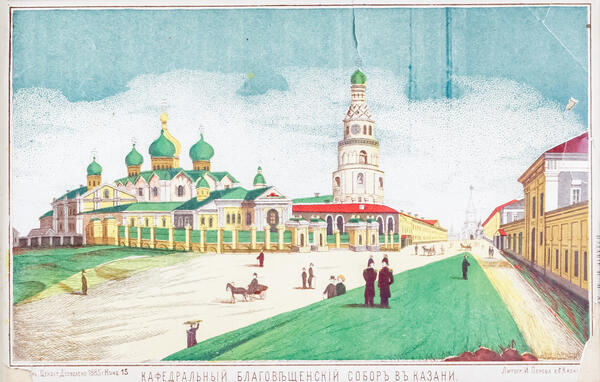The printed drawing “The Annunciation Cathedral in Kazan” was created using the technique of lithography. Unlike engraving, lithography is characterized by using flat printing plates.
To get a print on paper, one first needs to grind a special lithographic stone. In this way lithographers achieve either an absolutely smooth surface, or, conversely, a rough texture. The drawing is applied with a special lithographic pencil or greasy ink, which enter into a chemical reaction with the stone. Then the mold is treated with acid and other substances. After that, the printing ink sticks only to those parts of the stone that had an image. The grease is washed off, paint is applied to the stone, it is put under pressure and transferred from a flat plate to paper.
The Annunciation Cathedral in the Kazan Kremlin occupies a special place in Russian history and culture. Its location was personally chosen by Tsar Ivan the Terrible. First, a wooden Annunciation Church was built there; it was consecrated in October 1552. Nine years later, in May 1561, in accordance with the tsar’s decree, 80 stonemasons from Pskov began building a new church: they erected it from the white Volga limestone, which was mined on the opposite high bank of the river.
For centuries, the Annunciation Cathedral has been the Orthodox center of Kazan. The Kazan icon of the Mother of God was brought to the liturgy in this cathedral in 1579, the Holy Martyr Patriarch Hermogen served there, almost all representatives of the Romanov dynasty visited the cathedral, St. John of Kronstadt performed a divine Liturgy to the saints.
In the cathedral shrine (ark) there is the main Orthodox relic of Kazan — a particle of the relics of St. Gury of Kazan, the first Archbishop of Kazan and Sviyazhsk. In the 20th century, the vessel was lost, but it was restored from pre-revolutionary photographs.
The artist created the lithograph in 1885, but at the same time he captured a slightly earlier view of the temple: this is how it looked in 1840, before the reconstruction. On the left side of the figure, you can see the warm winter church in honor of the Nativity of Christ, dismantled in 1841, as well as an expanded refectory, a fence and balconies. The temple began to look like this after renovation works in 1821. At the same time, the builders painted the domes green and replaced the roof of the winter Nativity of Christ Church.
To get a print on paper, one first needs to grind a special lithographic stone. In this way lithographers achieve either an absolutely smooth surface, or, conversely, a rough texture. The drawing is applied with a special lithographic pencil or greasy ink, which enter into a chemical reaction with the stone. Then the mold is treated with acid and other substances. After that, the printing ink sticks only to those parts of the stone that had an image. The grease is washed off, paint is applied to the stone, it is put under pressure and transferred from a flat plate to paper.
The Annunciation Cathedral in the Kazan Kremlin occupies a special place in Russian history and culture. Its location was personally chosen by Tsar Ivan the Terrible. First, a wooden Annunciation Church was built there; it was consecrated in October 1552. Nine years later, in May 1561, in accordance with the tsar’s decree, 80 stonemasons from Pskov began building a new church: they erected it from the white Volga limestone, which was mined on the opposite high bank of the river.
For centuries, the Annunciation Cathedral has been the Orthodox center of Kazan. The Kazan icon of the Mother of God was brought to the liturgy in this cathedral in 1579, the Holy Martyr Patriarch Hermogen served there, almost all representatives of the Romanov dynasty visited the cathedral, St. John of Kronstadt performed a divine Liturgy to the saints.
In the cathedral shrine (ark) there is the main Orthodox relic of Kazan — a particle of the relics of St. Gury of Kazan, the first Archbishop of Kazan and Sviyazhsk. In the 20th century, the vessel was lost, but it was restored from pre-revolutionary photographs.
The artist created the lithograph in 1885, but at the same time he captured a slightly earlier view of the temple: this is how it looked in 1840, before the reconstruction. On the left side of the figure, you can see the warm winter church in honor of the Nativity of Christ, dismantled in 1841, as well as an expanded refectory, a fence and balconies. The temple began to look like this after renovation works in 1821. At the same time, the builders painted the domes green and replaced the roof of the winter Nativity of Christ Church.



